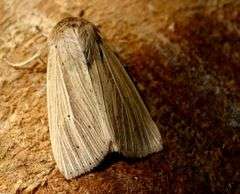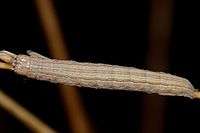Mythimna impura
| Smoky wainscot | |
|---|---|
 | |
| Scientific classification | |
| Kingdom: | Animalia |
| Phylum: | Arthropoda |
| Class: | Insecta |
| Order: | Lepidoptera |
| Family: | Noctuidae |
| Genus: | Mythimna |
| Species: | M. impura |
| Binomial name | |
| Mythimna impura Hübner, 1808 | |
Mythimna impura, the smoky wainscot, is a moth of the family Noctuidae. It is distributed throughout most of the Palearctic ecozone from Ireland in the west of Europe east to the Caucasus, Turkey, Syria, Kazakhstan, Russia, Siberia, Mongolia then Japan. In Europe it is found from the Arctic Circle to Spain and Italy (including Sicily) in the south, as well as in the northern regions of Greece.

As with other "wainscots", this species has buffish yellow forewings with prominent venation. The smoky wainscot has a dark basal streak with another shorter streak nearer to the costa and tornus. This species has grey hindwings with white margins. The wingspan is 31–38 mm. One or two broods are produced each year and adults can be seen at any time between June and October. It flies at night and is attracted to light, sugar and various flowers.
Technical description and variation
Forewing ochreous, with a rufous tinge;veins, especially the median, whiter, lined by fine brown streaks, which also appear in the interspaces: a dark shade below median nervure; a black clot at lower angle of cell; outer row of dots shown only by those on veins 2 and 5; hindwing dull grey. - ab. dungana Alph., from Turkestan and Tibet, is a darker, more fuscous, form in which the dark streaks become obscured; - ab. transbaikalensis Stgr. from Dauria has the forewing dusted with redbrown, and the dark streaks almost obsolete; — ab. amurensis Stgr. is wholly darker; the forewing with the white veins and the dark markings more distinct; - in ab. fuscipennis nov. [Warren] from Calabria and La Grave, Hautes Alpes, smaller than typical, the hindwing is blackish fuscous.[1]
Biology
The larva is brown or greyish ochreous, sometimes flesh-coloured; the lines pale with darker edges. It feeds on various grasses including Alopecurus, Dactylis, Deschampsia, Leymus and Phragmites and has also been recorded on the sedge, Carex and the rush, Luzula.[2] This species overwinters as a small larva.
References
- ^ The flight season refers to the British Isles. This may vary in other parts of the range.
- ↑ Seitz, A. Ed., 1914 Die Großschmetterlinge der Erde, Verlag Alfred Kernen, Stuttgart Band 3: Abt. 1, Die Großschmetterlinge des palaearktischen Faunengebietes, Die palaearktischen eulenartigen Nachtfalter, 1914
- ↑ "Robinson, G. S., P. R. Ackery, I. J. Kitching, G. W. Beccaloni & L. M. Hernández, 2010. HOSTS - A Database of the World's Lepidopteran Hostplants. Natural History Museum, London.".
- Chinery, Michael Collins Guide to the Insects of Britain and Western Europe 1986 (Reprinted 1991)
- Skinner, Bernard Colour Identification Guide to Moths of the British Isles 1984
External links
| Wikimedia Commons has media related to Mythimna impura. |
